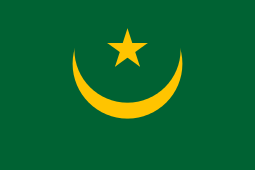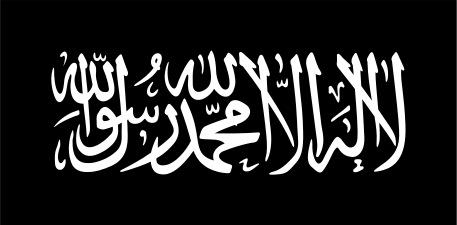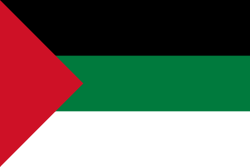Islamic flags
An Islamic flag is a flag either representing Islam, a concept or person related to Islam, or a state, military force or other entity associated with political Islam.
The flags of contemporary Islamic states tend to use one or several of the pan-Arab colors (black, red, white, green) and sometimes religious inscriptions such as the shahada or the takbir. The shahada has also become popular as an inscription on jihadist flags since the 1990s.
History
Early Islam
During the time of Muhammad, early Muslim armies and caravans flew simple solid-coloured flags (generally black or white) for identification purposes. In later generations, the Muslim leaders continued to use a simple black, white, or green flag with no markings, writings, or symbolism on it. Muhammad used flags of different colours in different Ghazwat (or campaigns commanded by Muhammad himself) and Saraya (or campaigns commanded by Sahabah, the companions of Muhammad). The major flag of Muhammad, the Black Standard, was known as al-ʿUqāb "the Eagle"; it was pure black, without symbols or markings. Its name and colour was derived from the flag of the Quraysh, one of the tribes of Arabia, whose flag was black with an eagle and was also known as "the Eagle".
Middle Ages

Religious flags with inscriptions were in use in the medieval period, as shown in miniatures by 13th-century illustrator Yahya ibn Mahmud al-Wasiti. 14th-century illustrations of the History of the Tatars by Hayton of Corycus (1243) shows both Mongols and Seljuqs using a variety of war ensigns.
The crescent appears in flags attributed to Tunis from as early as the 14th century Book of Knowledge of All Kingdoms, long before Tunis fell under Ottoman rule in 1574. The Spanish Navy Museum in Madrid shows two Ottoman naval flags dated 1613; both are swallow-tailed, one green with a white crescent near the hoist, the other white with two red stripes near the edges of the flag and a red crescent near the hoist.[1]
Ottoman Empire

War flags came into use by the Ottoman Empire in the 16th century, gradually replacing (but long coexisting with) their traditional tugh or horse-tail standards. During the 16th and 17th centuries, war flags often depicted the bifurcated sword of Ali, Zulfiqar, which was often misinterpreted in Western literature as showing a pair of scissors.[2]
A Zulfiqar flag used by Selim I (d. 1520) is on exhibit in Topkapı Palace.[3] Two Zulfiqar flags are also depicted in a plate dedicated to Turkish flags in vol. 7 of Bernard Picart's Cérémonies et coutumes religieuses de tous les peuples du monde (1737), attributed to the Janissaries and Sipahis.

Tanzimat of 1844, the flags of the Ottoman Empire were redesigned in the style of European armies of the day. The flag of the Ottoman Navy was made red as red was to be the flag of secular institutions and green of religious ones. As the reforms abolished all the various sub-sultanates, pashaliks, beyliks and emirates, a single new flag was designed to replace all the various flags used by these entities with one single national flag. The result was the red and white flag with the crescent moon and star, which is the precursor to the modern Turkish flag. A plain red flag was introduced as the civil ensign for all Ottoman subjects.
Modern history
- Star and crescent
By the mid 20th century, the star and crescent was used by a number successor states of the Ottoman Empire, including Algeria, Azerbaijan, Mauritania, Tunisia, Turkey, the Turkish Republic of Northern Cyprus and Libya.
Because of its supposed "Turkic" associations, the symbol also came to be used in Central Asia, as in the flags of Turkmenistan and Uzbekistan. The star-and-crescent in the Flag of Pakistan is stated as symbolizing "progress and light" (while the green colour is stated as representing Islam). The star-and-crescent in these flags was not originally intended as religious symbolism, but an association of the symbol with Islam seems to have developed beginning in the 1950s or 1960s.[4] By the 1970s, this symbol was embraced by both Arab nationalism or Islamism, such as the proposed Arab Islamic Republic (1974) and the American Nation of Islam (1973).[5]
- The Pan-Arab flag and colours

The Pan-Arab colors were first introduced in 1916, with the Flag of the Arab Revolt. Although they represent secular Arab nationalism as opposed to Islamism, the choice of colours has been explained by Islamic symbolism in retrospect, so by Mahdi Abdul Hadi in Evolution of the Arab Flag (1986): black as the Black Standard of Muhammad, the Rashidun Caliphate and the Abbasid Caliphate, white as the flag of the Umayyad Caliphate, green as the flag of the Fatimid Caliphate and red as the flag of the Khawarij.
On 30 1917 Hussein bin Ali, Sharif of Mecca, leader of the Arab Revolt replaced his plain red flag with one horizontally striped in black, green, and white with a red triangular area at the hoist. This was seen as the birth of the pan-Arab flag.
Since that time, many Arab nations, upon achieving independence or upon change of political regime, have used a combination of these colours in a design reflecting the Hejaz Revolt flag. These flags include the current flags of Iraq, Syria, Yemen, Egypt, Kuwait, United Arab Emirates, Jordan, Palestinian National Authority, Algeria, and Sudan, and former flags of Iraq and Libya.
Contemporary flags
Islamic states
The modern conceptualization of the Islamic state is attributed to Abul A'la Maududi (1903–1979), a Pakistani Muslim theologian who founded the political party Jamaat-e-Islami and inspired other Islamic revolutionaries such as Ruhollah Khomeini.
Six internationally recognized states identify as Islamic states: Saudi Arabia (formed 1932 out of the Wahhabist predecessor states), Pakistan (since 1947), Mauritania (since 1958), Iran (since 1979), Yemen (since 1991), and Afghanistan (since 2004, and before 1973). The majority of countries of the Arab world define Islam as their state religion. Most of these states have national flags that include Islamic symbolism. Besides, there are unrecognized jihadist de facto states, such as the Islamic State of Iraq and the Levant controlling parts of Iraq and Syria, and the Taliban, Al-Shabaab and Boko Haram ruling parts of Afghanistan, Somalia and Nigeria, respectively, which use jihadist flags.
 The flag of Saudi Arabia (1932, based on a 1921 variant), the shahada and a sword on a green field
The flag of Saudi Arabia (1932, based on a 1921 variant), the shahada and a sword on a green field The flag of Iran (1980), a highly stylized emblem representing the word Allah
The flag of Iran (1980), a highly stylized emblem representing the word Allah The flag of Afghanistan (2004, in variants since 1928) shows the national emblem, depicting a mosque with a mehrab with a prayer mat inside below the shahada
The flag of Afghanistan (2004, in variants since 1928) shows the national emblem, depicting a mosque with a mehrab with a prayer mat inside below the shahada The flag of Libya (2011) is a revival of the 1951 flag of the kingdom of Libya, and as such contains no religious symbolism (in spite of the provisional constitution of 2011 declaring Islam as state religion and the sharia as basis for legislation).[7]
The flag of Libya (2011) is a revival of the 1951 flag of the kingdom of Libya, and as such contains no religious symbolism (in spite of the provisional constitution of 2011 declaring Islam as state religion and the sharia as basis for legislation).[7] The flag of Pakistan, a star-and-crescent on green .The green represents Islam and the majority Muslims in Pakistan and the white stripe represents religious minorities and minority religions.[6] In the centre, the crescent and star symbolizes progress and light respectively.[6] The flag symbolizes Pakistan's commitment to Islam and the rights of religious minorities.[7] It is based on the original flag of the Muslim League, which itself drew inspiration from the flag of the Sultanate of Delhi, the flag of Ottoman Empire and the Flag of the Mughal Empire.representing Islam.[8]
The flag of Pakistan, a star-and-crescent on green .The green represents Islam and the majority Muslims in Pakistan and the white stripe represents religious minorities and minority religions.[6] In the centre, the crescent and star symbolizes progress and light respectively.[6] The flag symbolizes Pakistan's commitment to Islam and the rights of religious minorities.[7] It is based on the original flag of the Muslim League, which itself drew inspiration from the flag of the Sultanate of Delhi, the flag of Ottoman Empire and the Flag of the Mughal Empire.representing Islam.[8] The flag of Mauritania (1959), star-and-crescent on green.
The flag of Mauritania (1959), star-and-crescent on green. The flag of Yemen (1990), in spite of the constitutional definition of Yemen as an Islamic state implementing the sharia, does not include religious symbolism.
The flag of Yemen (1990), in spite of the constitutional definition of Yemen as an Islamic state implementing the sharia, does not include religious symbolism. The flag of Iraq (2008, variants since 1991) has the takbir inscribed on the Arab tricolor. The 2008 constitution identifies Islam as state religion, and requires legislation to be compliant with sharia.
The flag of Iraq (2008, variants since 1991) has the takbir inscribed on the Arab tricolor. The 2008 constitution identifies Islam as state religion, and requires legislation to be compliant with sharia.
Jihadist flags

The Taliban replaced their solid white flag with a white flag inscribed with the shahada in black when they established the Islamic Emirate of Afghanistan in 1997.
Since the late 1990s, it has become popular among jihadists to display black flags inscribed with the shahada in this style. The flag has been dubbed the "black flag of Jihad" in western media.
Inscribed flags

Some flags of Muslim states or jihadist groups use inscribed flags, either with the shahada, as in the flags of Saudi Arabia, or in the case of the 1979 Islamic Republic of Iran, stylized writing of the word Allah. The flag of Iraq uses the pan-Arab colours since 1921, with the addition of the takbir since 1991.
The practice of inscribing the shahada on flags may go back the 18th century, used by the Wahhabi religious movement.[9] In 1902 Ibn Saud, leader of the House of Saud and the future founder of the Kingdom of Saudi Arabia, added a sword to this flag.[9] The current flag of Saudi Arabia is a continuation of the flag Emirate of Nejd and Hasa introduced in 1902. The First East Turkestan Republic of 1933 used it on their flag, and the Taliban introduced it on their flag of Afghanistan in 1997.
Representation of flags
Unlike the practice in most Western nations, flags are usually depicted in Islamic countries with the staff to the right. This is analogous to the right-to-left form of most Arabic and Arabic-influenced scripts. This can make for confusion when flag images are shown without an accompanying flagstaff, as it may not be immediately obvious which way around the flag is being depicted.
In keeping with Islamic law, Muslim flags generally do not bear any representations of live creatures. Some Arab flags today bear the "Eagle of Saladin", originally introduced in the Egyptian Revolution of 1952, as a symbol of Pan-Arabism.
See also
References
- ↑ Nozomi Karyasu & António Martins, 8 October 2006 on Flags of the World.
- ↑ e.g. Jaques Nicolas Bellin, Tableau des Pavillons de le nations que aborent à la mer (1756).
- ↑ Ottoman Empire: Flags and coats of arms shown in the Topkapi Museum (Istanbul)
- ↑ The symbolism of the star and crescent in the flag of the Kingdom of Libya (1951–1969) was explained in an English language booklet, The Libyan Flag & The National Anthem, issued by the Ministry of Information and Guidance of the Kingdom of Libya (year unknown, cited after Jos Poels at FOTW, 1997) as follows: "The crescent is symbolic of the beginning of the lunar month according to the Muslim calendar. It brings back to our minds the story of the Hijra (migration) of our Prophet Mohammed from his home in order to spread Islam and teach the principles of right and virtue. The Star represents our smiling hope, the beauty of aim and object and the light of our belief in God, in our country, its dignity and honour which illuminate our way and puts an end to darkness."
- ↑ Edward E. Curtis, Black Muslim religion in the Nation of Islam, 1960-1975 (2006), p. 157.
- ↑ Pan-Arab Colours, crwflags.com; Mahdi Abdul-Hadi, The Great Arab Revolt, passia.org
- ↑ The flag replaces the solid-green flag of Libya under Gaddhafi 1977–2011, strongly reminiscent of the solid-green flag of the Fatimid Caliphate but not officially stated as symbolizing religion so much as Gaddhafi's political philosophy.
- ↑ "Pakistan flag". Ministry of Information and Broadcasting, Government of Pakistan. Retrieved 2007-12-11.
- 1 2 Firefly Guide to Flags of the World. 2003. p. 165. ISBN 978-1552978139. Retrieved 12 September 2012.
External links
- Islamic flags at Flags of the World
- Historic flags of Islam (Flags of the World website)
- The Flag of Quraish (Flags of the World website
- "Crescent Moon: Is It a Symbol of Islam?" on Islam.about.com
- blackflags1.blogspot.com (August 2010)
